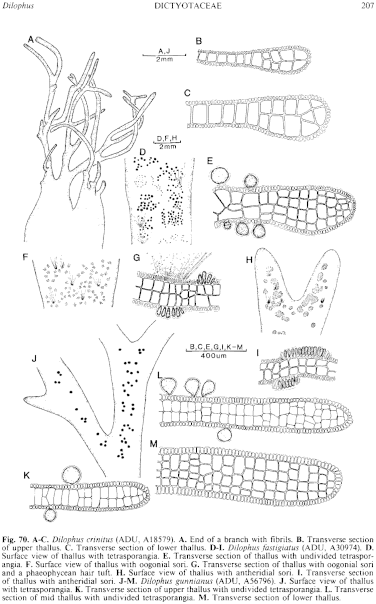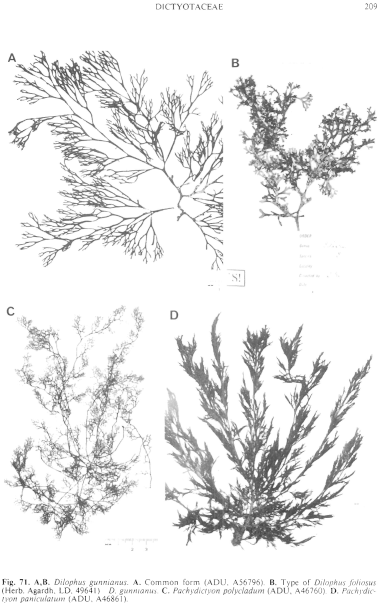|
|
|
|
|
|||||||||||
|
Electronic Flora of South Australia Species Fact Sheet
Phylum Phaeophyta – Order Dictyotales – Family Dictyotaceae – Tribe Dictyoteae
Selected citations: Womersley 1967: 212.
Synonyms
D. opacus J. Agardh 1882: 107; 1849a: 88. Womersley 1967: 213. D. fasciculatus J. Agardh 1894a: 87. Womersley 1967: 214. D. foliosus J. Agardh 1894a: 94. Womersley 1967: 212.
D. taeniaeformis J. Agardh 1894a: 88. Womersley 1967: 213. D. wilsonii J. Agardh 1894a: 90. Womersley 1967: 214.
Thallus (Fig. 71A,B) medium to dark brown, 5–20 (–25) cm long, with single or clustered axes from a matted base, regularly dichotomously branched below and much branched above dichotomously or becoming alternate, at intervals of 0.5–2 (–6) cm, branches (0.5–) 1–2 (–5) mm broad, of fairly even width throughout or with branch ends becoming slightly spathulate (especially when proliferous), axils and apices rounded, with the apical cell not or slightly protruding; proliferations usually absent, occasionally abundant and mainly marginal. Holdfast rhizoidal; epilithic. Cortical cells 10–20 µm across, L/B 1–2 (–3). Medulla near apices (1–) 2 cells thick in centre of branches and (2–) 3–4 cells thick near the margins (Fig. 70K), soon becoming 2–4 cells thick (Fig. 70L) and usually 4 cells thick (Fig. 70M) throughout older parts (in some specimens 5–7 cells thick); thickness in upper parts 140–200 µm centrally, 160–250 µm marginally, in older parts 300–500 (–600) µm thick throughout. Hair tufts scattered, hairs 14–20 µm in diameter.
Reproduction: Tetrasporangia (Fig. 70J–L) 100–160 (–200) µm in diameter, scattered, usually sparse. Oogonial sori relatively small, round to ovate, 200–500 µm long and 200–300 µm across; oogonia 100–150 µm long and 60–100 µm in diameter. Antheridial sori elongate ovate, densely scattered, 400–900 µm long and 240–600 µm across; antheridia (50–) 60–120 µm long and 20–40 µm in diameter.
Type from S. Aust. (Curdle, ex Herb. Harvey); in Herb. Agardh, LD, lectotype 49540.
Selected specimens: Israelite Bay, W. Aust., drift (Wells, 10.xii.1974; ADU, A46085). Marion Bay, S. Aust., drift (Kraft, 18.ix.1973; ADU, A44533). Goldsmith Beach (S. of Edithburgh), S. Aust., drift ( Womersley, 20.ix.1981; ADU, A52941). Brighton, S. Aust., drift (Bienert, 12.xi.1965; ADU, A29662). Aldinga, S. Aust., drift (Womersley, 31.xii.1967; ADU, A32197). Kingscote, Kangaroo I., S. Aust., upper sublittoral ( Womersley, 2.i.1950; ADU, Al2794, much branched above). E. side Ballast Head, Kangaroo I., S. Aust., drift (Womersley, 28.xii.1948; ADU, A10453, slightly proliferous). E. end D'Estrees Bay, Kangaroo I., S. Aust., outer reef pool (Womersley, I 1 .i.1950; ADU, Al2703). Pennington Bay, Kangaroo I., S. Aust., reef pools (Womersley, 1.xi.1947; ADU, A6127, slender form) and 3 m deep (Mitchell, 20.viii.1963; ADU, A26990, with long, distant, branches). Victor Harbor, S. Aust., drift (Womersley, 2.xi.1965; ADU, A29629, proliferous). Yilki, Victor Harbor, S. Aust., drift (Womersley, 30.ix.1985; ADU, A56796). Robe, S. Aust., drift (Womersley, 16.i.1971; ADU, A37824, proliferous). Swan Bay, Port Phillip, Vic., drift (Walker & Sanderson, 4.xii.1983; ADU, A55426, lower branches relatively broad). S. of Crawfish Rock, Westernport Bay, Vic., 9 m deep (Watson, 30.16.1968; ADU, A33587). Ulverstone, Tas., drift (Gordon, 18.i.1966; ADU, A30112, proliferous). Bridport, Tas., drift (Womersley & Parsons, 6.xi.1982; ADU, A54538).
Distribution: From Israelite Bay, W. Aust. to Westernport Bay, Vic. and the N. coast of Tasmania.
Taxonomic notes: The following five species names are now placed in synonymy with Dilophus gunnianus. While further studies are clearly desirable, particularly on populations collected in situ, no satisfactory differences between them are apparent at present.
D. opacus J. Agardh is based on a Port Phillip, Vic., specimen of Mueller in LD (lectotype 49568). It has relatively broad branches for D. gunnianus, but resembles this species in that the branches are frequent, relatively short, and commonly lateral.
D. fasciculatus J. Agardh is based on a Western Port, Vic., specimen of Wilson (8.i.1892), in LD (49549), which is fairly typical of D. gunnianus.
D. foliosus J. Agardh is based on a Port Phillip, Vic., specimen of Wilson (probably Jan. 1882), in LD (lectotype, 49641), which has become proliferous from the margins; similar specimens (e.g. ADU, A10453, A29629) are present in ADU and do not appear to be specifically different.
D. taeniaeformis J. Agardh is based on a Port Phillip, Vic., specimen of Mueller, in LD (49563). The rather distant branching is similar to that of D. fastigiatus, but the branches are of similar width to D. gunnianus, are robust and the medulla is 4 cells thick throughout; other such specimens in ADU (e.g. Al2703) come from rough-water habitats.
D. wilsonii J. Agardh is based on a Port Phillip Heads, Vic., specimen of Wilson, in LD (49595). It is typical of D. gunnianus.
Dilophus gunnianus is thus regarded as a somewhat variable species, especially in habit, with the branches generally 1–2 mm broad (in shallower water reef forms with broader lower branches and slenderer, much divided, upper parts), branching dichotomous and usually becoming lateral above at fairly short intervals. The medulla becomes 2 cells thick centrally close to the apices and in most forms becomes 4 cells thick both centrally and marginally; in some robust forms it may become 5–7 cells thick. Reef plants often have clumped bases with several axes, whereas deeper water plants are often with a single axis and more openly branched.
Narrower forms, probably referable to D. gunnianus, occur on the coast of Western Australia and merit further study.
References:
AGARDH, J.G. (1882). Till algernes systematik. Acta Univ. lund. 17, 1–136, Plates 1–3.
AGARDH, J.G. (1894a). Analecta Algologica. Cont. I. Acta Univ. lund. 29, 1–144, Plates 1, 2.
WOMERSLEY, H.B.S. (1967). A critical survey of the marine algae of southern Australia. II. Phaeophyta. Aust. J. Bot. 15, 189–270.
The Marine Benthic Flora of Southern Australia Part II complete list of references.
Publication:
Womersley, H.B.S. (14 December, 1987)
The Marine Benthic Flora of Southern Australia
Part II
©Board of the Botanic Gardens and State Herbarium, Government of South Australia
Illustrations in Womersley Part II, 1997: FIGS 70 J–M, 71A,B.

Figure 70 enlarge
Fig. 70. A–C. Dilophus crinitus (ADU, A18579). A. End of a branch with fibrils. B. Transverse section of upper thallus. C. Transverse section of lower thallus. D–I. Dilophus fastigiatus (ADU, A30974). D. Surface view of thallus with tetrasporangia. E. Transverse section of thallus with undivided tetrasporangia. F. Surface view of thallus with oogonial sori. G. Transverse section of thallus with oogonial sori and a phaeophycean hair tuft. H. Surface view of thallus with antheridial sori. I. Transverse section of thallus with antheridial sori. J–M. Dilophus gunnianus (ADU, A56796). J. Surface view of thallus with tetrasporangia. K. Transverse section of upper thallus with undivided tetrasporangia. L. Transverse section of mid thallus with undivided tetrasporangia. M. Transverse section of lower thallus.

Figure 71 enlarge
Fig. 71. A,B. Dilophus gunnianus. A. Common form (ADU, A56796). B. Type of Dilophus foliosus (Herb. Agardh, LD, 49641)=D. gunnianus. C. Pachydictyon polycladum (ADU, A46760). D. Pachydictyon paniculatum (ADU, A46861).

|
Email Contact: State Herbarium of South Australia |

|